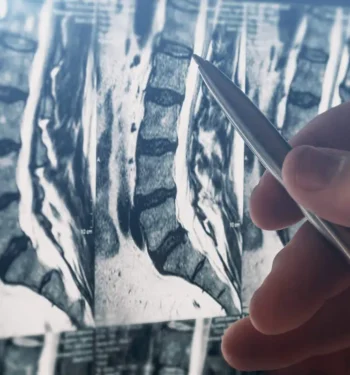
Understanding Spinal Stenosis and When Surgery Is Considered
Spinal stenosis is a narrowing of the spinal canal that puts pressure on the spinal cord and nerves, often causing pain, weakness, or numbness. For many, these symptoms interfere with daily life; walking, standing, or even sitting comfortably can become difficult. Common symptoms that may lead a physician to recommend surgical evaluation include persistent leg or arm pain, tingling, or loss of balance.
Conservative treatments such as physical therapy, medications, and injections are often tried first. But when these spinal stenosis treatment options no longer provide relief, surgery may be considered. Signs that it may be time for surgical intervention include progressive neurological symptoms, severe pain that limits activity, or significant loss of mobility.
Patients often ask, “What level of spinal stenosis requires surgery?” and “Is it worth having surgery for spinal stenosis?” The answer to both questions can vary, but generally, surgery is considered when daily function is significantly impaired. If you’re seeking spinal stenosis treatment in Indiana, Goodman Campbell specialists are available to help evaluate when surgery may be appropriate.
What Types of Surgery Are Used for Spinal Stenosis?
Spinal decompression surgery is the most common approach, relieving pressure on nerves by creating more space in the spinal canal. A lumbar laminectomy removes a portion of the vertebra, while lumbar decompression and fusion may be performed for additional stability. In the neck, cervical decompression and fusion are often recommended to restore function and reduce pain.
Some patients may benefit from minimally invasive fusion techniques, which reduce recovery time and minimize scarring. At Goodman Campbell, surgeons offer advanced procedures, including laminectomy, decompression surgeries, and cervical fusion, tailored to each patient.
Two of the most commonly asked questions about spinal stenosis are: “What is the most successful surgery for spinal stenosis?” and “What is the success rate of surgery for cervical spinal stenosis?” The answer to both questions largely depends on the patient and type/severity of their condition; however, when matched appropriately to symptoms, outcomes are generally strong.
How Long Does Spinal Stenosis Surgery Take and What Is Recovery Like?
The answer to how long spinal stenosis surgery takes depends on the type of procedure being conducted. A simple decompression may take 1–2 hours, while fusion can take longer. Some surgeries may be done on an outpatient basis, while some may require a short hospital stay.
Recovery time varies, but most patients who undergo decompression begin walking soon after surgery and gradually resume activities. With rehabilitation and follow-up care, many regain mobility and return to active lives almost immediately.
What Is the Success Rate of Surgery for Spinal Stenosis?
So, what is the success rate of surgery for cervical spinal stenosis? Research shows that 80%–90% of patients undergoing decompression experience significant relief from leg pain. The spinal decompression surgery success rate is particularly strong when symptoms stem from nerve compression.
Outcomes for cervical decompression and fusion are similarly positive, often resulting in improvements in pain, balance, and independence. Factors such as age, health, and underlying conditions influence results and ultimate spinal stenosis surgery success rates. Goodman Campbell is committed to providing expert, compassionate care to help bring about the best possible outcome for each patient. In fact, a devoted quality team monitors outcomes across the entire practice to ensure our patients continue to report positive long-term results.
Can Spinal Stenosis Come Back After Surgery, and What Are the Risks?
Some patients may worry, “What are the risks of spinal stenosis surgery?” While there are potential spinal stenosis surgery risks, including infection, bleeding, or nerve injury, most patients undergo these procedures safely, with serious complications being rare thanks to advances in surgical techniques and careful monitoring. In some cases, symptoms may recur due to ongoing degenerative changes in the spine; while recurrence rates are relatively low, ongoing care and healthy lifestyle choices can help minimize risk.
Goodman Campbell surgeons have advanced expertise in treating spinal stenosis. They reduce risks by adhering to rigorous safety protocols and providing personalized follow-up care to support long-term recovery and optimal outcomes.
Are There Limitations, Costs, and New Treatments to Consider?
Other common questions when it comes to spinal stenosis surgery usually include:
- What is the age limit for spinal stenosis surgery?
- There is no strict age limit for spinal stenosis surgery. Overall, health matters more than age.
- What is the spinal stenosis surgery cost?
- Spinal stenosis surgery cost depends on the procedure, hospital stay, and insurance coverage. Minimally invasive approaches and recovery length can also affect expense. Patients should review details with their care team and insurance provider.
- What is the spinal stenosis death rate?
- Fortunately, the spinal stenosis death rate is extremely low, making these procedures among the safest in neurosurgery.
- What is the newest treatment for spinal stenosis?
- Innovative options include minimally invasive fusion, motion-preserving procedures, and enhanced recovery pathways. At Goodman Campbell, patients benefit from cutting-edge research and advanced treatments designed to improve outcomes and reduce recovery time.
Ready To Start Your Journey? Ask Your Doctor About Goodman Campbell
You may ask, “Is it worth having surgery for spinal stenosis?” For many patients, the answer is yes. Numerous patient success stories highlight how lives have been transformed through surgery and expert care. At Goodman Campbell, surgeons and interventional pain management physicians provide guidance, support, and advanced treatment every step of the way.
Request an appointment or ask your doctor if Goodman Campbell is right for you, and take the first step toward reclaiming your quality of life.


